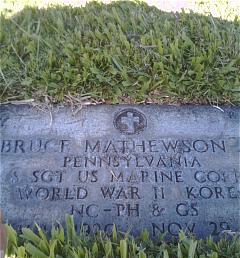 |
| A photograph of Bill's grave from Findagrave.com. |
You may remember from an earlier post that Bruce is one of only six Pennsylvania veterans of the Korean War buried in Hawaii's National Memorial Cemetery of the Pacific. Six seems like an awfully small number for a conflict that claimed a total of 2,401 lives from my state. (You can see a listing of all casualties, by state, at this Archives website.) To understand why this is so, I draw on what I learned from Lauren's research and the Normandy Institute.
In World Wars I and II the next of kin for deceased American soldiers were offered a choice for their loved one's remains: interment overseas in a U.S. cemetery or repatriation to the U.S. If brought back to the U.S., that serviceman may be buried by the family or a U.S. cemetery here. This policy was the result of a compromise, struck in World War I and maintained in World War II. The majority of families, in World War II at least, opted to have their loved ones repatriated.
In the Korean War, the situation for America's deceased changed quite a bit. The shifting nature of the war, and its uncertain end, motivated to return all bodies to the United States. Bruce's family was offered the choice for his permanent burial: return to the family or burial in a U.S. Cemetery.
 |
| First Division Marines salute fallen comrades who were buried after the escape from Chosin. |
I find this part of the story particularly compelling. Bruce was killed on November 29 in what is now North Korean territory. Before evacuating to near the 38th parallel, the First Marines buried their fallen in a temporary grave. Files from the National Archives even indicate exactly where Bruce was buried at first. The detail the Marines took here for a temporary grave strikes me in a profound way.
You'll note that the record indicates the Marine buried beside him as well. According to Findagrave, PFC Kitchens is buried at a church cemetery on North Carolina.
 |
| Paperwork indicating the precise location of Bruce's temporary grave. |
Bruce's first resting place was behind enemy lines. His wife was promptly notified of his death, but had no means of recovering his body at that time.
And so the war came. And ended, mercifully, in 1953.
In 1954, the Marines notified Bruce's family that his remains had been recovered and positively identified. By this point, however, Bruce's widow had remarried. Next-of-kin rights reverted to his parents, who requested that he be buried in Hawaii at the National Memorial Cemetery of the Pacific. According to them, this was Bruce's wish.
It's likely no one from the family has ever visited his grave. One communication from his widow indicated that the family would not be able to attend his funeral in Hawaii. I'm surmising that the age of his parents precluded them from attending it. Bruce's children were young - 10, 8, and 6 - at the time of his funeral and younger still at the time of his death. I have no indication whether or not they ever visited their dad's grave.
Therefore, I might be the one visitor from home paying their respects to Bruce.
- - -
In the World War II era the majority of families asked for their loved ones to be returned to home. Based on the records I have from the Punchbowl, it would seem the majority wanted the same in Korea, too. Before school ended I was sharing some of my findings from Bruce's file with a friend at school, a friend who happens to be a Marine Mom (her son is currently serving as Marine Infantry). She said it made sense that the parents would opt for burial with his comrades and she could see how a parent would view this choice differently than a widow. Though anecdotal, I think her comment is helpful.
After all, it's consistent with the story from Bill's family. Lauren's soldier was buried overseas after a compromise was struck between the grieving widow and the grieving parents. It's also consistent with the public stance taken by the Roosevelt family in World War I, when the former president and his wife insisted that their son, Quentin, be buried where the foeman laid him.
Comments
Post a Comment